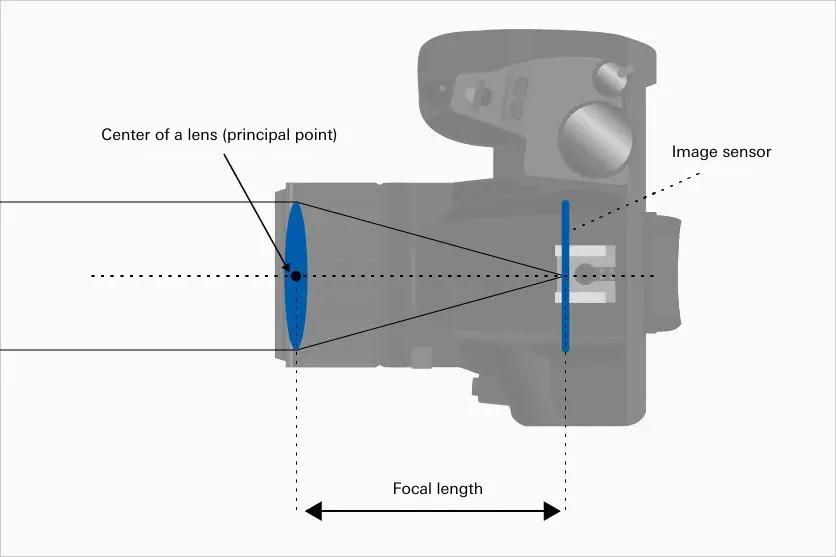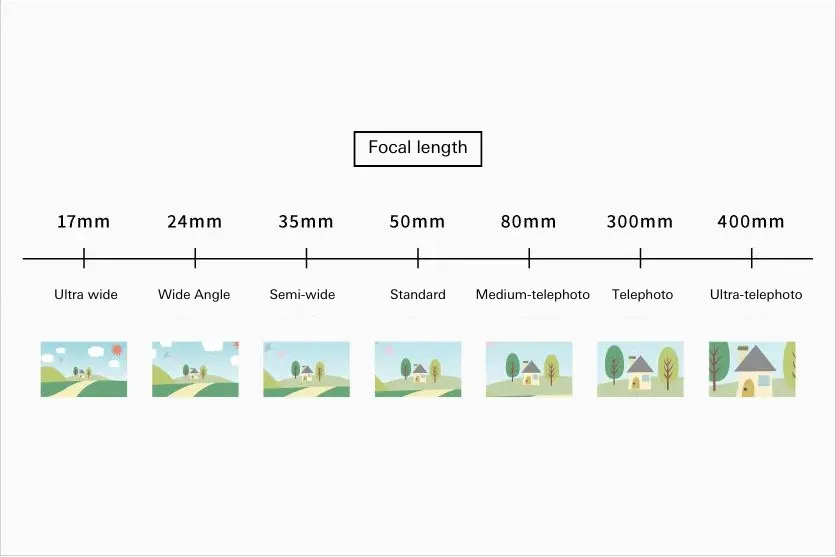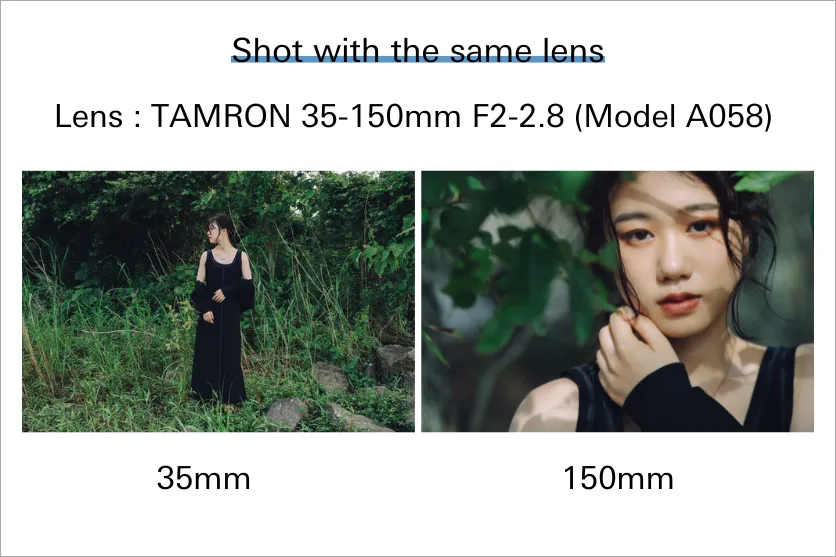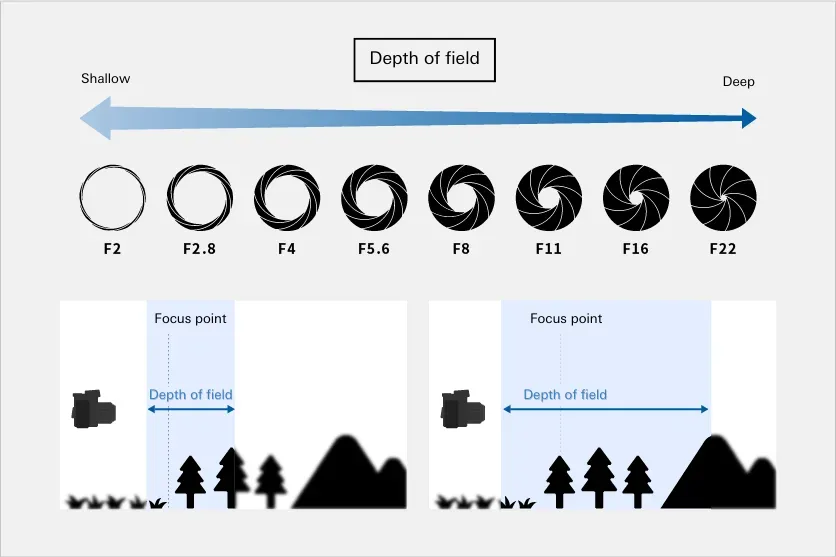April 26, 2024
What is focal length? Explanation of basic knowledge about angle of view and focal length
What is focal length? Explanation of basic knowledge about angle of view and focal length


Here is some basic knowledge about focal length with interchangeable lenses that you will need to know when shooting with an SLR or mirrorless SLR camera. When shooting with an interchangeable lens camera, you can take beautiful and impressive photos by working with the angle of view, focus point and degree of bokeh. Particularly when choosing a lens, it is important to understand the characteristics of focal length as the angle of view changes depending on focal length. Let’s learn the basic knowledge and make use of it to take the photos as you imagine.
When light enters a lens, the point where the light gathers is called the focal point. While light travels in a straight ray, when it passes through a lens it refracts and is concentrated at a single point so called focal point. When a light passes through a lens and at this focal point it forms an image, when an image sensor is placed at this position, the image can be captured.
A focal length is a distance from the center of the lens (principal point) to the image sensor, and this is an important value that characterizes a lens.
Generally, on a camera lens there is an indication of focal length. For a product name such as “28-75mm F/2.8, ” this “xx mm” indicates the focal length.
There are two types of lenses: prime lenses which have a single focal length, and zoom lenses that have a variable focal length. If the focal length is described with a range, such as “xx-xx mm,” it is a zoom lens. For a prime lens, only a single figure is indicated, such as “xx mm.”
Example of a zoom lens: 28-75mm F/2.8 Di III VXD G2 (Model A063)
Example of a prime lens: 20mm F/2.8 Di III OSD M1:2 (Model F050)
The important point about focal length is that the angle of view changes with its actual number. The angle of view is the angle of area captured by the camera through the lens, and the larger the angel of view, the wider the area is captured.
Lens types can be roughly divided into three categories: wide-angle, standard, and telephoto. A standard lens can capture images at an angle of view close to that of the human field of view. Generally, lenses with a wider angle of view are called wide-angle lenses, and lenses with a narrower angle of view are called telephoto lenses.
As a general rule of thumb for focal lengths, focal length smaller than 35mm are generally classified into wide-angle lens, lenses around 50mm are called standard lens, and lenses larger than 80mm are telephoto lens.
Check out the differences in impression and composition caused by changing the angle of view. Here is an example of a portrait taken with the TAMRON 35-150mm F/2-2.8 Di III VXD (Model A058) at a different focal length.
At the wide-angle end (35 mm), the beautiful impression of the figure standing stands out with the background. At the telephoto end (150 mm), on the other hand, the expression on the person's face is compelling and the background bokeh accentuates this image. In this way, by changing the focal length of a zoom lens, various angles of view can be created, and different impressions can be captured.
Another characteristic of focal length is depth of field. Depth of field refers to the range in which the image looks it is in focus, and a deep depth of field means that the image looks in focus through wide range, such as from a subject to background. And if the depth of field is shallow, only the area around the subject will be in focus and the background will have a smooth bokeh.
The shorter the focal length of the lens and the larger the aperture (F-number), the deeper the depth of field. This is why wide-angle lenses are suitable for landscape photography, as the short focal length increases the depth of field and allows the photographer to capture details in the background clearly.
On the other hand, as telephoto lenses have a long focal length and shallow depth of field, the bokeh in the background of a subject is more pronounced. By utilizing these bokeh effects, you can capture portraits and other images where the subject stands out against the background.
As explained above, focal length is a very important figure, but when choosing a lens you also need to be mindful of the sensor size on your camera body.
With digital SLR cameras, light reaching the image sensor is stored as an electrical charge, and an image is created based on the color information obtained through the color filter.
These image sensors come in mainly two types: 35mm full-frame, and APS-C. The size of a 35mm full-frame sensor is 36mm x 24mm. The larger the sensor size allows a wider area to be captured with greater sensitivity and its rich gradation. On the other hand, the size of an APS-C sensor is a step smaller at 23.5mm x 15.6mm* and captures narrower area.
*APS-C image sensor sizes vary by camera.
Therefore, you will need a lens that is compatible with the sensor size of the camera body. Camera lenses have a specific sensor size that they are compatible with, so choose a lens that is compatible with the camera you have. When APS-C camera is used, you will need to do some calculation to figure out the real coverage.
The angle of view of each focal length depends on the sensor size. Generally, focal lengths and angles of view are based on 35mm full-frame size, so when selecting an APS-C compatible lens, it is easier to understand the angle of view when converted to full-frame size. Such conversion is known as '35mm equivalent'.
In general, the focal length of APS-C lenses can be converted to the focal length of lenses for full-frame cameras by multiplying the focal length by 1.5 (for Sony, Nikon and 1.6 for Canon). The relationship between angle of view and focal length can be mapped as shown in the table below, which you can use as a reference when selecting a lens for APS-C.
In addition to the focal length, the F-number (aperture value) is another important figure that expresses the characteristics of the lens: the smaller the F-number, the more light-gathering power it will have, and will broaden your possibility.
The F-number is calculated as 'focal length ÷ lens effective diameter'. The smaller the 'maximum aperture F value' when the aperture is at its widest, the more sensitive the lens is. When choosing a lens, it is better to mind the F-number as well as the focal length.
Here are TAMRON's recommended lenses by lens type. TAMRON zoom lenses cover a wide range of focal lengths with a single lens yet are of a size that makes them easy to carry. On top of this, they are characterized by their high descriptive performance and close-up shooting ability. We hope you will find the lens that suits you best.
Wide-angle zoom lenses cover the range from ultra wide-angle to standard range. Ultra wide-angle lenses allow you to get closer to buildings and vehicles and still capture a wide range of subjects, resulting in more dynamic shots. It also allows for unique portrait and pet photography, making the most of the perspective. Lightweight and compact TAMRON lenses are particularly useful when shooting landscapes, as the time and distance spent carrying them around can be long.
-

-
11-20mm F/2.8 Di III-A RXD b060(Model )
11-20mm F/2.8 Di III-A RXD (Model B060) is the world's first compact, lightweight F2.8 ultra wide-angle zoom lens for Sony E-mount APS-C mirrorless cameras. Can be a great choice for video shooting.
-
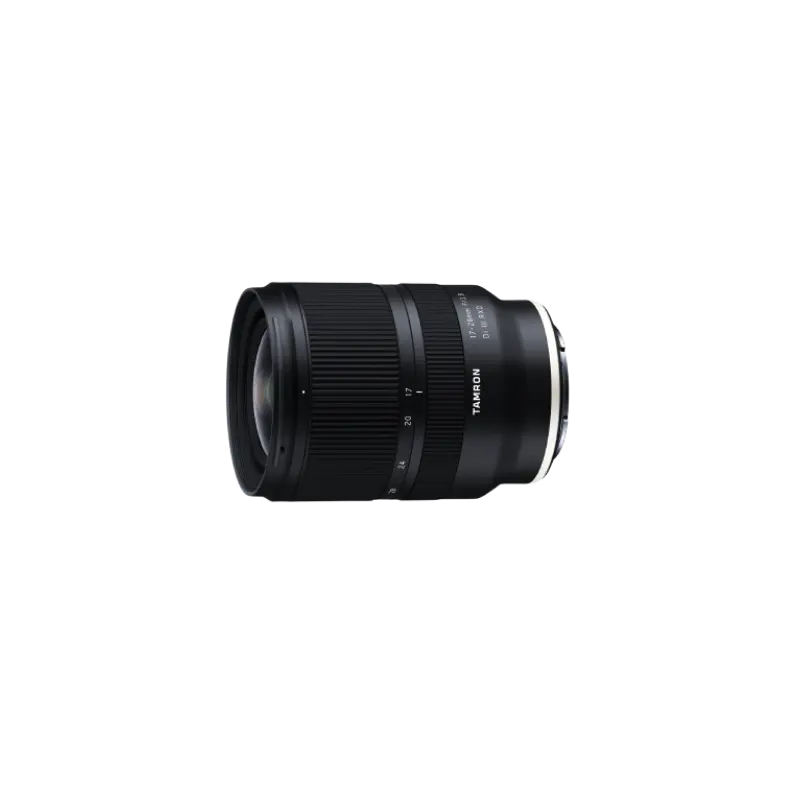
-
17-28mm F/2.8 Di III RXD a046(Model )
The 17-28mm F/2.8 Di III RXD (Model A046) achieves a filter diameter of ø67mm, which is surprising for a large aperture ultra wide-angle zoom lens for full-frame cameras. It’s small and light weight with a good camera balance. It's a dedicated lens for mirrorless interchangeable -lens cameras that can be carried easily and can be used in various situations.
-
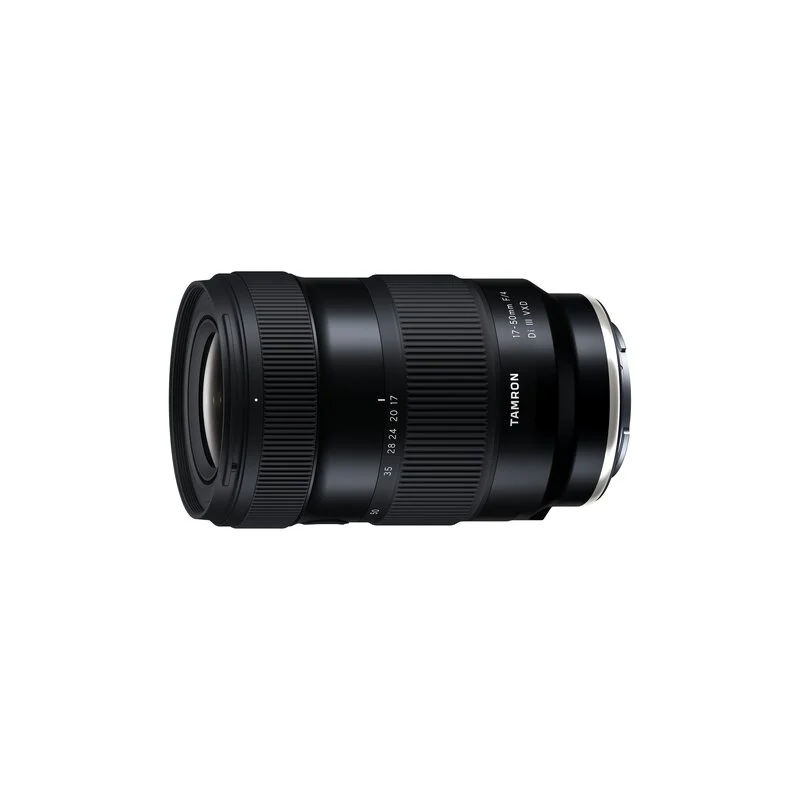
-
17-50mm F/4 Di III VXD a068(Model )
The 17-50mm F/4 Di III VXD (Model A068)It's the world’s first lens covering from ultra wide-angle 17mm to the standard 50mm focal length. The highly-compact TAMRON 17-50mm F/4 Di III VXD (model a068) for Sony E-mount full-frame mirrorless cameras offers maximum versatility for still and video creators. From landscapes to living rooms, this lens captures all that you see.
-

-
The 17-70mm F/2.8 Di III-A VC RXD b070(Model )
The 17-70mm F/2.8 Di III-A VC RXD (Model B070) is a large-aperture standard zoom lens for APS-C format mirrorless cameras. With a focal length range of 17mm to 70mm (a full-frame equivalent of 25.5-105mm) for daily use, this achieves a 4.1x zoom. The optical design ensures high resolution and high contrast not just in the center of the image but also in corners and at the edges. The quiet AF drive motor and the VC image stabilization mechanism facilitate hand-held shooting. In addition, by counteracting focus breathing, the 17-70mm F2.8 empowers users' expression of their creative intentions to the fullest degree. This highly practical lens allows you to easily enjoy the high image quality of a large F2.8 aperture for both still and video shooting.
-

-
20-40mm F/2.8 Di III VXD a062(Model )
The 20-40mm F/2.8 Di III VXD (Model A062) is a new large-aperture standard zoom lens that thoroughly pursues portability. While covering the range from the ultra-wide angle of 20mm to the standard range of 40mm, it is the smallest and lightest in its class. It also offers high image quality throughout the entire zoom range, making it useful not only for still image shooting but also for video recording such as vlogging. The VXD, which is quiet and agile, achieves high-speed, high-precision autofocusing. It is a new, unprecedented large-aperture standard zoom lens that allows users to easily enjoy taking out and shooting both still and video.
-

-
28-75mm F/2.8 Di III VXD G2 a063(Model )
28-75mm F/2.8 Di III VXD G2 (Model A063) is the second-generation fast-aperture standard zoom lens for Sony and Nikon full-frame mirrorless cameras, offering significantly improved optical and autofocus performance and new function customization.
Telephoto zoom lenses enable photographers bring the subject closer, making them ideal for events such as sports events, as well as for birding and wildlife. They are also useful in natural landscapes photographed in conjunction with trekking, hiking and mountaineering.
They are also recommended for impressive portrait photography with naturally blurred backgrounds and compression effects.
-
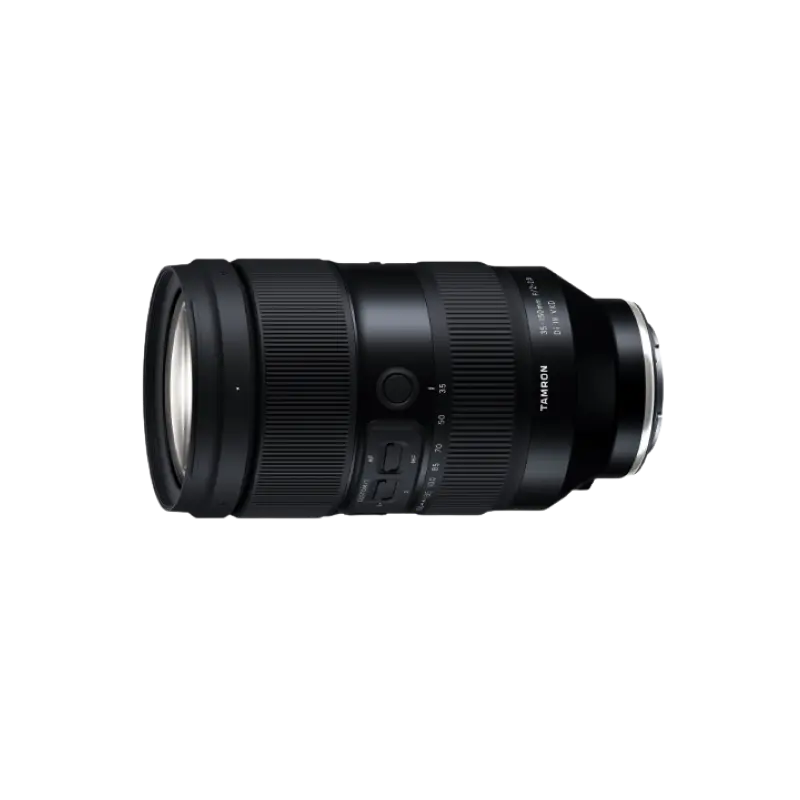
-
35-150mm F/2-2.8 Di III VXD a058(Model )
The 35-150mm F/2-2.8 Di III VXD (Model A058) is a high resolution travel zoom lens that covers everything from the 35mm wide angle to the 150mm telephoto focal length, the first zoom lens achieving an aperture of F2 at the wide angle end. It has a groundbreaking fast-aperture and utilizes the linear motor focus mechanism VXD (Voice-coil eXtreme-torque Drive), thereby achieving high speed, high precision autofocusing. The innovative lens design enabled us to greatly improve the lens's grip and functionality. The software, developed in-house, enables to easily customize functions and to update firmware.
-
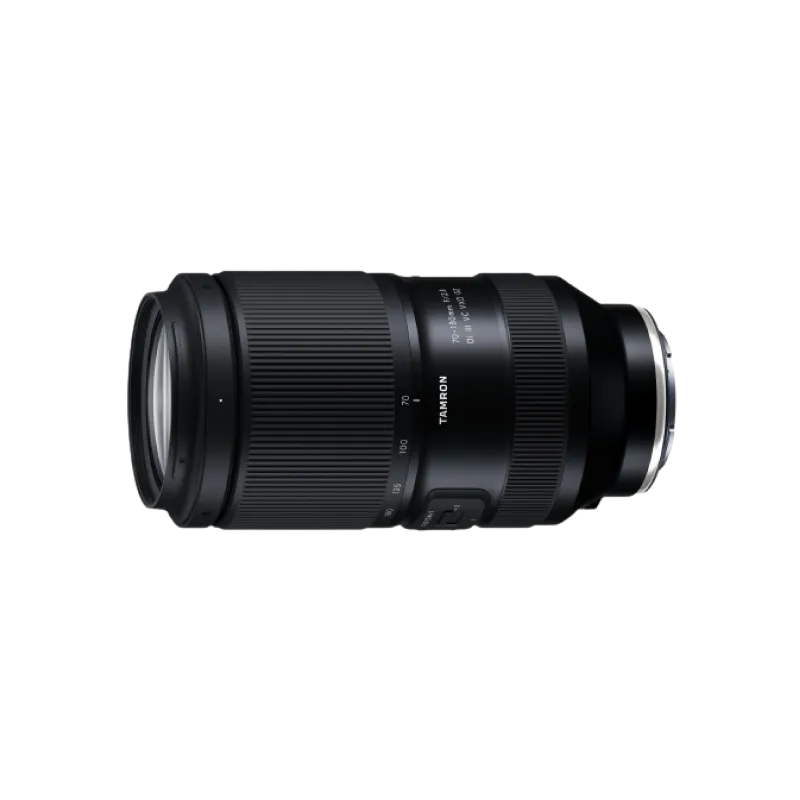
-
70-180mm F/2.8 Di III VC VXD G2 a065(Model )
70-180mm F/2.8 Di III VC VXD G2 (Model A065) has evolved to G2 level.This is the world’s smallest and lightest, fast-aperture telephoto zoom lens for Sony E-mount with astounding portability and superb image quality.
-

-
70-300mm F/4.5-6.3 Di III RXD a047(Model )
The 70-300mm F/4.5-6.3 Di III RXD (Model A047) for full-frame mirrorless cameras is a telephoto zoom lens designed and created so photographers of all skill levels can enjoy high quality images comfortably. The 70-300mm F4.5-6.3 covers a broad telephoto zoom range yet is the small and lightest weight. With special emphasis on resolving power, TAMRON has deployed special lens elements appropriately arranged to correct chromatic aberration, generally very strong in a telephoto lens, as well as other aberrations. Users can enjoy high-resolution images combined with stunning bokeh qualities that are achievable only with a telephoto lens. The lens also incorporates the RXD, a high-speed precision AF drive system that is remarkably quiet. The 70-300mm F4.5-6.3 is a versatile lens for photographing landscapes, sports and other action, pets, wildlife, and more. The lens also demonstrates its potential for portrait shooting, casual snapshots, and scenarios that require you to be mobile and shoot handheld, like sporting events.
As ultra-telephoto zoom lenses allow you to enlarge the faraway subjects, they are best suited for shooting subjects you cannot get close to, such as wildlife, sporting events held at large venues, aircraft and trains. By combining the compression effects and bokeh that telephoto zooms are known for, you can also compose more appealing images.
-

-
50-400mm F/4.5-6.3 Di III VC VXD a067(Model )
The 50-400mm F/4.5-6.3 Di III VC VXD (Model A067) is an ultra-telephoto zoom lens with an 8x zoom starting at 50mm at the wide-angle end and compatible with full-frame mirrorless cameras. The lens delivers uncompromised high image quality over the entire 50-400mm focal length range, yet is as compact and lightweight as a 100-400mm class lens. Equipped with the VXD mechanism and the VC mechanism, the lens can quickly focus on the subject's movement when shooting sports and wild birds. The 50-400mm F4.5-6.3 is a new ultra-telephoto zoom lens that combines unparalleled image quality and mobility.
-
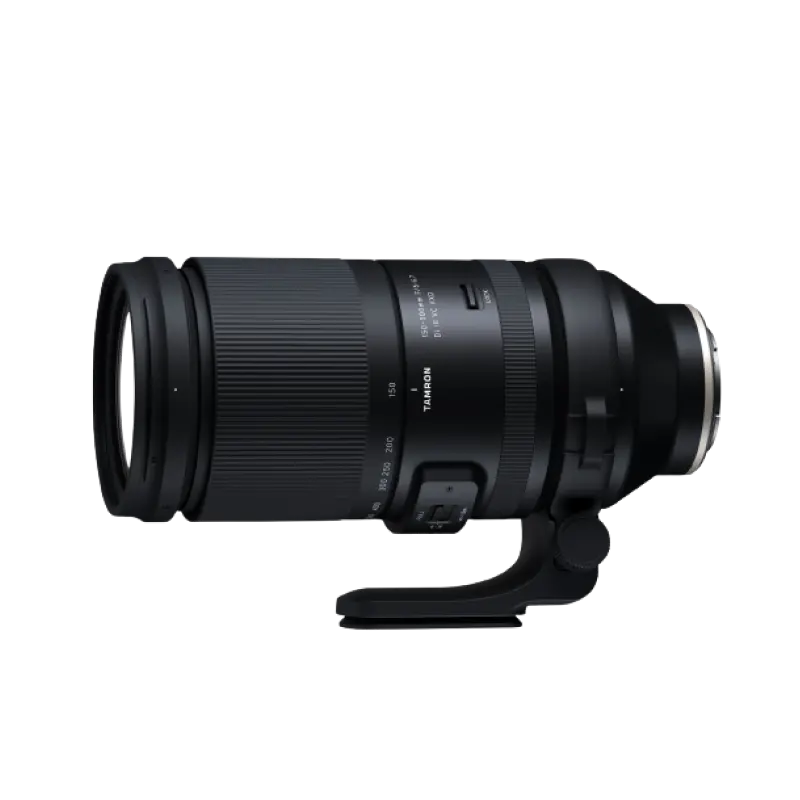
-
150-500mm F/5-6.7 Di III VC VXD a057(Model )
The 150-500mm F/5-6.7 Di III VC VXD (Model A057) is compact enough to be handheld while maintaining a focal length of 500mm on the telephoto end. It allows users to easily enjoy the world of the 500mm ultra-telephoto lens while maintaining its high image quality. The high-speed, high-precision AF with excellent tracking performance and the VC mechanism support handheld shooting in the ultra-telephoto range.
The focal length of a lens is defined as the distance from the center of the lens (principal point) to the image sensor of the camera. Focal length is an important figure that determines the angle of view. A lens with a short focal length is a wide-angle lens, a lens with a long focal length is a telephoto lens and a standard lens is somewhere in between. When choosing a lens, pay attention to the focal length and select a lens that suits the subject or scene you want to photograph.

Lens Featured in this Impression
-

-
35-150mm F/2-2.8 Di III VXD a058(Model )
The 35-150mm F/2-2.8 Di III VXD (Model A058) is a high resolution travel zoom lens that covers everything from the 35mm wide angle to the 150mm telephoto focal length, the first zoom lens achieving an aperture of F2 at the wide angle end. It has a groundbreaking fast-aperture and utilizes the linear motor focus mechanism VXD (Voice-coil eXtreme-torque Drive), thereby achieving high speed, high precision autofocusing. The innovative lens design enabled us to greatly improve the lens's grip and functionality. The software, developed in-house, enables to easily customize functions and to update firmware.
-

-
11-20mm F/2.8 Di III-A RXD b060(Model )
Product Page | 11-20mm F/2.8 Di III-A RXD (Model B060) is the world's first compact, lightweight F2.8 ultra wide-angle zoom lens for Sony E-mount APS-C mirrorless cameras. Can be a great choice for video shooting.
-

-
17-70mm F/2.8 Di III-A VC RXD b070(Model )
The 17-70mm F/2.8 Di III-A VC RXD (Model B070) is a large-aperture standard zoom lens for APS-C format mirrorless cameras. With a focal length range of 17mm to 70mm (a full-frame equivalent of 25.5-105mm) for daily use, this achieves a 4.1x zoom. The optical design ensures high resolution and high contrast not just in the center of the image but also in corners and at the edges. The quiet AF drive motor and the VC image stabilization mechanism facilitate hand-held shooting. In addition, by counteracting focus breathing, the 17-70mm F2.8 empowers users' expression of their creative intentions to the fullest degree. This highly practical lens allows you to easily enjoy the high image quality of a large F2.8 aperture for both still and video shooting.
-

-
35-150mm F/2-2.8 Di III VXD a058(Model )
The 35-150mm F/2-2.8 Di III VXD (Model A058) is a high resolution travel zoom lens that covers everything from the 35mm wide angle to the 150mm telephoto focal length, the first zoom lens achieving an aperture of F2 at the wide angle end. It has a groundbreaking fast-aperture and utilizes the linear motor focus mechanism VXD (Voice-coil eXtreme-torque Drive), thereby achieving high speed, high precision autofocusing. The innovative lens design enabled us to greatly improve the lens's grip and functionality. The software, developed in-house, enables to easily customize functions and to update firmware.
-

-
50-400mm F/4.5-6.3 Di III VC VXD a067(Model )
The 50-400mm F/4.5-6.3 Di III VC VXD (Model A067) is an ultra-telephoto zoom lens with an 8x zoom starting at 50mm at the wide-angle end and compatible with full-frame mirrorless cameras. The lens delivers uncompromised high image quality over the entire 50-400mm focal length range, yet is as compact and lightweight as a 100-400mm class lens. Equipped with the VXD mechanism and the VC mechanism, the lens can quickly focus on the subject's movement when shooting sports and wild birds. The 50-400mm F4.5-6.3 VC is a new ultra-telephoto zoom lens that combines unparalleled image quality and mobility.

